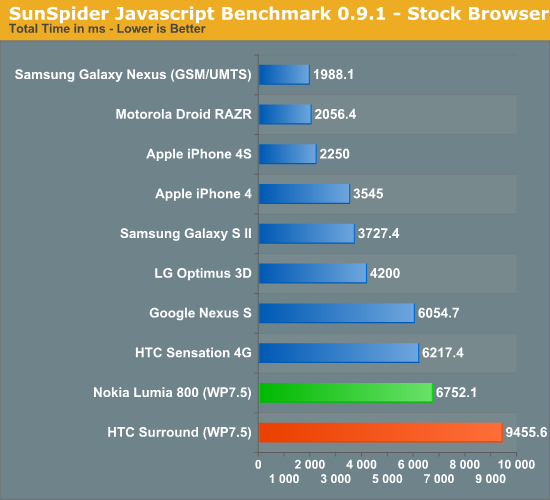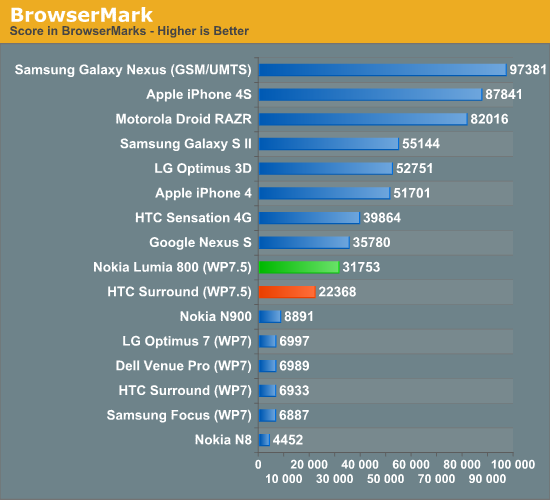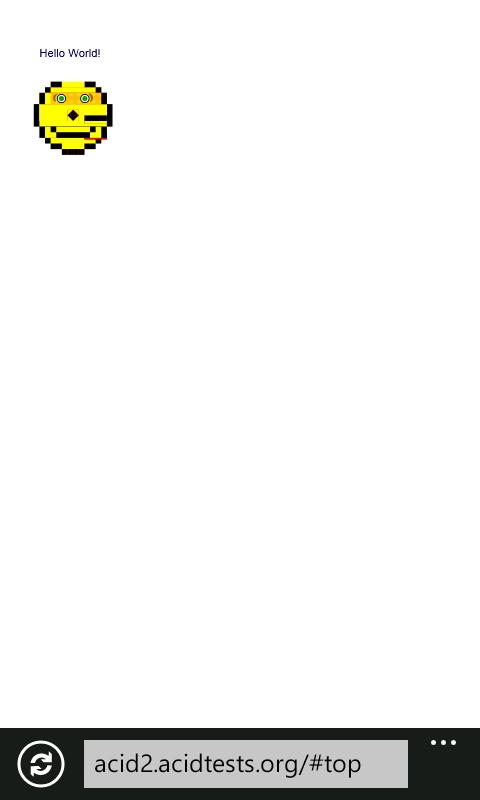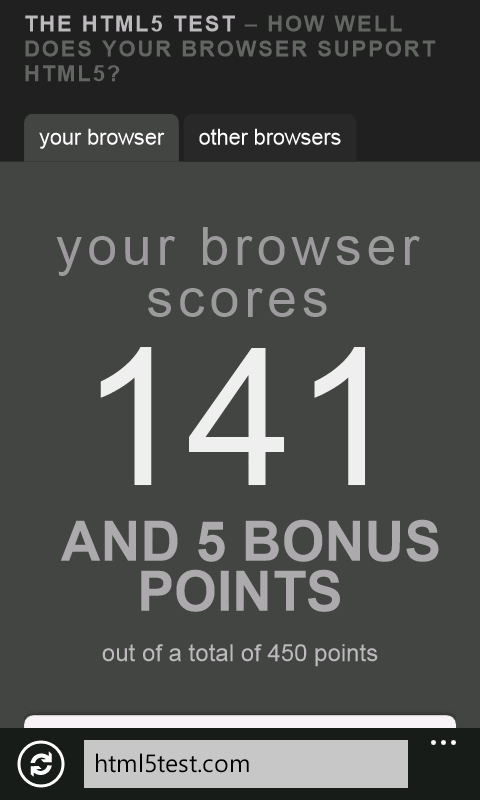Nokia Lumia 800 Review - Nokia's Brave New Foray into WP7
by Brian Klug on January 4, 2012 7:00 AM EST- Posted in
- Smartphones
- Nokia
- windows phone 7
- Mobile
- WP7
- Lumia
- Lumia 800
Unfortunately, the majority of benchmarks that usually grace our smartphone reviews don’t yet have WP7 ports or analogs, but there are a still a number of comparisons we can make. To start, the browser-based performance metrics give a good picture within the Windows Phone ecosystem, and likewise with WPbench, created by one of our own readers and on the marketplace.
There’s been a lot written about performance on WP7 already - namely that comparative analysis isn’t as big of a deal as it is on other smartphone platforms, but of course this is more the result of two things. First, Microsoft’s careful curation of their new smartphone platform with hardware requirements; second, availability of native and managed code execution environments. For the most part, you can pick up any WP7 device and have very good expectation of UI smoothness, but that’s not to say there aren’t differences, especially as the platform moves from one generation of Snapdragon SoC to the next, and now possibly even a move to ST-E. Benchmarking WP7 (and by analog, Windows 8) will become a big deal very soon, however, and numerous SoC vendors and big names in the PC benchmarking scene are looking to port to these platforms.
This current refresh of WP7 devices continues to be based around exclusively Qualcomm SoCs, and the Lumias are no exception. Both the 710 and 800 are based around Qualcomm’s MSM8255 single core S2 Snapdragon at 1.4 GHz with Adreno 205 graphics at the core and dual channel LPDDR2 memory interfaces. This is a 45nm part we’ve seen and explored numerous times before, and as a refresher includes the HSPA+ 14.4 baseband onboard.
Anyhow, onward to the numbers. First is sunspider, which we’ve been using for a long while and recently changed from 0.9 to 0.9.1 with. As a result, I’ve had to re-run devices since the numbers aren’t directly comparable. WP7.5 brings a much improved javascript engine which gives it a big boost in scores. I’ve managed to hang onto the HTC Surround (1.0 GHz QSD8250) and Anand has the Focus (also 1.0 GHz QSD8250), which we’ve included as well.

Browsermark hasn’t changed or forced us to re-run things, so we have comparison numbers that show how much difference there is in the browser department in WP7.5.

In the synthetics, WP7.5’s new JavaScript engine (Chakra) with JIT brings perf almost up to modern levels and is a step in the right direction, but it’s still behind iOS and Android. Moving to a higher clocked single core probably does make sense for Windows Phone, especially if IE is single threaded at this point.
For system benchmarking on WP7.5 we have WP Bench, which was created by one of our own readers. The benchmark reports a total score in addition to three sub-scores for CPU, memory, and GPU. My only point of comparison, again, is the HTC Surround.
| WPBench Comparison | ||
| HTC Surround (1.0 GHz QSD8250) | Nokia Lumia 800 (1.4 GHz MSM8255) | |
| Total Score | 59.85 | 91.14 |
| Result Screenshot |
|
|
Browser Performance and Changes
I’ve made a big deal about browsing performance because, for me at least, the stock browser is the one place where performance really must be flawless. OEMs are starting to wake up to the fact that browsing performance makes a huge impact on the overall subjective weighting of a platform’s smoothness, which in turn results in a lot of scrutiny. I’d agree with this assertion as well and toss in a few other things that must be flawless for a platform to feel speedy.
When WP7.5 first started surfacing we took a look at its revamped IE9-based browser which uses Trident 5.0 as opposed to NoDo’s Trident 3.1. Unsurprisingly everything we saw in the emulator applies to the real-world experience with WP7.5 on live devices. Actually things are even a bit better than they were when we played around in the emulator.


The Windows Phone team has made clear several times that they aren’t going to build the browser to any tests but instead real-world page rendering accuracy. That said it’s still worthwhile to take a look at the synthetics. Acid 3 now completes and nearly passes (the boxes in top right subtract some points) where it previously scored below 95. Similarly Acid 2 now is almost flawless. Finally, the HTML5test score increases from 130 to 141 on the Lumia 800 and newer WP7.5 builds, which is a slight but still important difference.

Moving away from Trident 3.1 to 5.0 has made a huge difference on faithful page rendering and eliminated nearly all of the annoying edge cases I saw with previous WP7 smartphones. A number of pages I visit daily back when we did those reviews would render but with a few notable errata, these are now gone completely.
In addition, scrolling performance remains just as speedy as it was before (essentially buttery smooth) as the rendering architecture remains largely the same. We now have all three platforms (WP7.5, iOS, and Android 3.x/4.x) rendering the browser page into a texture that can be translated, clipped, and zoomed with GPU operations. It’s clear that this is the right way to do things to keep the browser UI speedy.
The changes to WP7.5’s browser make (for me at least) the single most notable improvement over NoDo and previous iterations. It’s a huge step forwards in rendering, compliance, and UI, and having that browser experience be as close to perfect as possible is tremendously important.












120 Comments
View All Comments
465thGTG - Wednesday, January 4, 2012 - link
Sounds like you aren't thoroughly familiar with Windows Phone. As far as performance goes, my Titan consistently feels faster and more fluid than my Galaxy S II, which has ungodly specs. Benchmarks may paint one picture, but real world use paints a completely different one.Speaking of the Titan, I can't believe Brian didn't mention it at all. Its camera is a clear step above both the Focus S and Lumia 800.
doubledeej - Thursday, January 5, 2012 - link
What evidence do you have for WP7 needing dual core? My HTC HD7 runs circles around my coworker's Galaxy S II with a lower clock speed and half of the number of cores.WP7 renders graphics using the GPU so everything feels fast and fluid. Android doesn't even attempt to do that until 3.0 (which isn't available on phones). ICS adds it, but not many models are getting that yet.
AMOLED is beautiful. Fully saturated colors and infinite contrast ratio. I'd take an AMOLED at half of the rated brightness of an LCD any day. The AMOLED screens in production aren't too dim. But some of the LCDs can get too bright.
french toast - Thursday, January 5, 2012 - link
I agree AMOLEDS are awesome!, i havnt seen a modern one but i saw my mates HTC desire when that came out and it was cool, if they have improved since then then i want one!I havnt used WP7 so i cant comment on responsivness, but what i will say is that multi cores devices actually bring the power consumption DOWN, whilst making something that can be multithreaded eg web browsing even smoother, it also gives games developers power to make better games, the GPU on the old snapdragon is weak, so while the OS may run smooth thanks to miccrosofts supreme optimizations,you cant tell me you wouldnt want better more powerfull engine inside, that gives better battery life as well as better games would you?
Either way, WP7 whilst clearly very slick, is selling like ice creams in antartica, and i think this has to do with the pecieved out of date specs, like NFC duel core LTE etc, people want the lastest gadgets with the same stuff there friends have..
Microsoft MUST start delivering some up to date hardware.
LB-ID - Wednesday, January 4, 2012 - link
Brian, just FYI. Article's last page, paragraph three:"at least min my mind"
I believe that should be: "at least in my mind".
Thanks for the article and analysis!
Brian Klug - Wednesday, January 4, 2012 - link
Fixed!-Brian
Brian Klug - Wednesday, January 4, 2012 - link
Thanks for all the edits/corrections everyone, I've made a number of changes (all those listed here). :)-Brian
comomolo - Wednesday, January 4, 2012 - link
I understand Nokia doesn't want the N9 to succeed or their Windows Phone strategy is doomed. But this is an independent news site, isn't it? Where's the N9 in the comparison charts? Where's the N9 review? Comparing the Lumia with the phone it inherited the design from (the N9) is only logical. Hiding it from your readers is not very professional.Yes, Nokia decided to "kill" Meego (that's just a public statement; it's obviously their "plan B" and will be the basis for their upcoming "low end" Meltemi), but for a whole lot of people who couldn't care less about "ecosystems" (which is just a new euphemism for "lock-in"), its applications offer is pretty nice. In some areas, like telephony, is much better than anything else on the market, and because it's fairly open, lots of hacks and community apps and add-ons are being developed every day. Honestly, unless you lack any knowledge of technology (and then, why would you want a smartphone?) the N9 is currently offering much better value than the Lumia or any other Windows Phone 7 device.
Belard - Wednesday, January 4, 2012 - link
I'm looking at jumping from Android to WPx... as it is, I am running the free WP7 Launcher on my Android that makes using the phone so much easier than the default Android one.I see postings from WP7 owners wishing the titles would rotate with the phone (As we know, not even iOS and Android does this)...
But there is the cool thing, the WP7 Launcher for Android *DOES* rotate the tiles - which not only looks cool, its handy and allows you to read the titles. Of course the wide titles can't rotate, but this function would SO be worth it.
Voldenuit - Wednesday, January 4, 2012 - link
Thanks for the great review!Minor nitpick, though. The F number by convention is reported as a reciprocal when used with lower case 'f', and as a normal number when used with upper case 'F'. It's just one of those weird notation conventions in photography.
Example:
f/2.0 == F2.0 == an aperture with a diameter half the focal length of the lens.
Camera geek with N8 in hand ;).
Solidstate89 - Wednesday, January 4, 2012 - link
If they could get that rumored Lumia 900 on Sprint with the 4.3" screen, I would finally be able to switch to a pure software keyboard. The keyboard WP7 uses is utterly fantastic, from its sound to its autocorrect. It's juts great. However on the 3.6" screen on my Arrive, it's a bit cramped even when in landscape mode. However something as large as 4.3" is certainly enough to make me move.